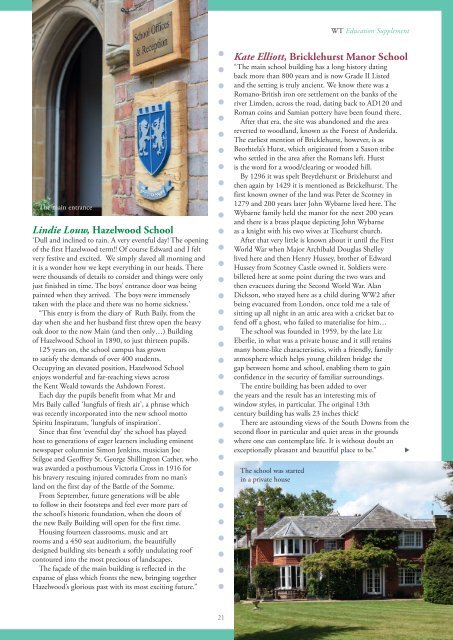Wealden Times | WT175 | September 2016 | Education supplement inside
Wealden Times - The lifestyle magazine for the Weald
Wealden Times - The lifestyle magazine for the Weald
You also want an ePaper? Increase the reach of your titles
YUMPU automatically turns print PDFs into web optimized ePapers that Google loves.
WT <strong>Education</strong> Supplement<br />
The main entrance<br />
Lindie Louw, Hazelwood School<br />
‘Dull and inclined to rain. A very eventful day! The opening<br />
of the first Hazelwood term!! Of course Edward and I felt<br />
very festive and excited. We simply slaved all morning and<br />
it is a wonder how we kept everything in our heads. There<br />
were thousands of details to consider and things were only<br />
just finished in time. The boys’ entrance door was being<br />
painted when they arrived. The boys were immensely<br />
taken with the place and there was no home sickness.’<br />
“This entry is from the diary of Ruth Baily, from the<br />
day when she and her husband first threw open the heavy<br />
oak door to the now Main (and then only…) Building<br />
of Hazelwood School in 1890, to just thirteen pupils.<br />
125 years on, the school campus has grown<br />
to satisfy the demands of over 400 students.<br />
Occupying an elevated position, Hazelwood School<br />
enjoys wonderful and far-reaching views across<br />
the Kent Weald towards the Ashdown Forest.<br />
Each day the pupils benefit from what Mr and<br />
Mrs Baily called ‘lungfuls of fresh air’, a phrase which<br />
was recently incorporated into the new school motto<br />
Spiritu Inspiratum, ‘lungfuls of inspiration’.<br />
Since that first ‘eventful day’ the school has played<br />
host to generations of eager learners including eminent<br />
newspaper columnist Simon Jenkins, musician Joe<br />
Stilgoe and Geoffrey St. George Shillington Cather, who<br />
was awarded a posthumous Victoria Cross in 1916 for<br />
his bravery rescuing injured comrades from no man’s<br />
land on the first day of the Battle of the Somme.<br />
From <strong>September</strong>, future generations will be able<br />
to follow in their footsteps and feel ever more part of<br />
the school’s historic foundation, when the doors of<br />
the new Baily Building will open for the first time.<br />
Housing fourteen classrooms, music and art<br />
rooms and a 450 seat auditorium, the beautifully<br />
designed building sits beneath a softly undulating roof<br />
contoured into the most precious of landscapes.<br />
The façade of the main building is reflected in the<br />
expanse of glass which fronts the new, bringing together<br />
Hazelwood’s glorious past with its most exciting future.”<br />
Kate Elliott, Bricklehurst Manor School<br />
“The main school building has a long history dating<br />
back more than 800 years and is now Grade II Listed<br />
and the setting is truly ancient. We know there was a<br />
Romano-British iron ore settlement on the banks of the<br />
river Limden, across the road, dating back to AD120 and<br />
Roman coins and Samian pottery have been found there.<br />
After that era, the site was abandoned and the area<br />
reverted to woodland, known as the Forest of Anderida.<br />
The earliest mention of Bricklehurst, however, is as<br />
Beorhtela’s Hurst, which originated from a Saxon tribe<br />
who settled in the area after the Romans left. Hurst<br />
is the word for a wood/clearing or wooded hill.<br />
By 1296 it was spelt Breytlehurst or Brixlehurst and<br />
then again by 1429 it is mentioned as Brickelhurst. The<br />
first known owner of the land was Peter de Scotney in<br />
1279 and 200 years later John Wybarne lived here. The<br />
Wybarne family held the manor for the next 200 years<br />
and there is a brass plaque depicting John Wybarne<br />
as a knight with his two wives at Ticehurst church.<br />
After that very little is known about it until the First<br />
World War when Major Archibald Douglas Shelley<br />
lived here and then Henry Hussey, brother of Edward<br />
Hussey from Scotney Castle owned it. Soldiers were<br />
billeted here at some point during the two wars and<br />
then evacuees during the Second World War. Alan<br />
Dickson, who stayed here as a child during WW2 after<br />
being evacuated from London, once told me a tale of<br />
sitting up all night in an attic area with a cricket bat to<br />
fend off a ghost, who failed to materialise for him…<br />
The school was founded in 1959, by the late Liz<br />
Eberlie, in what was a private house and it still retains<br />
many home-like characteristics, with a friendly, family<br />
atmosphere which helps young children bridge the<br />
gap between home and school, enabling them to gain<br />
confidence in the security of familiar surroundings.<br />
The entire building has been added to over<br />
the years and the result has an interesting mix of<br />
window styles, in particular. The original 13th<br />
century building has walls 23 inches thick!<br />
There are astounding views of the South Downs from the<br />
second floor in particular and quiet areas in the grounds<br />
where one can contemplate life. It is without doubt an<br />
exceptionally pleasant and beautiful place to be.”<br />
The school was started<br />
in a private house<br />
<br />
21 wealdentimes.co.uk


















